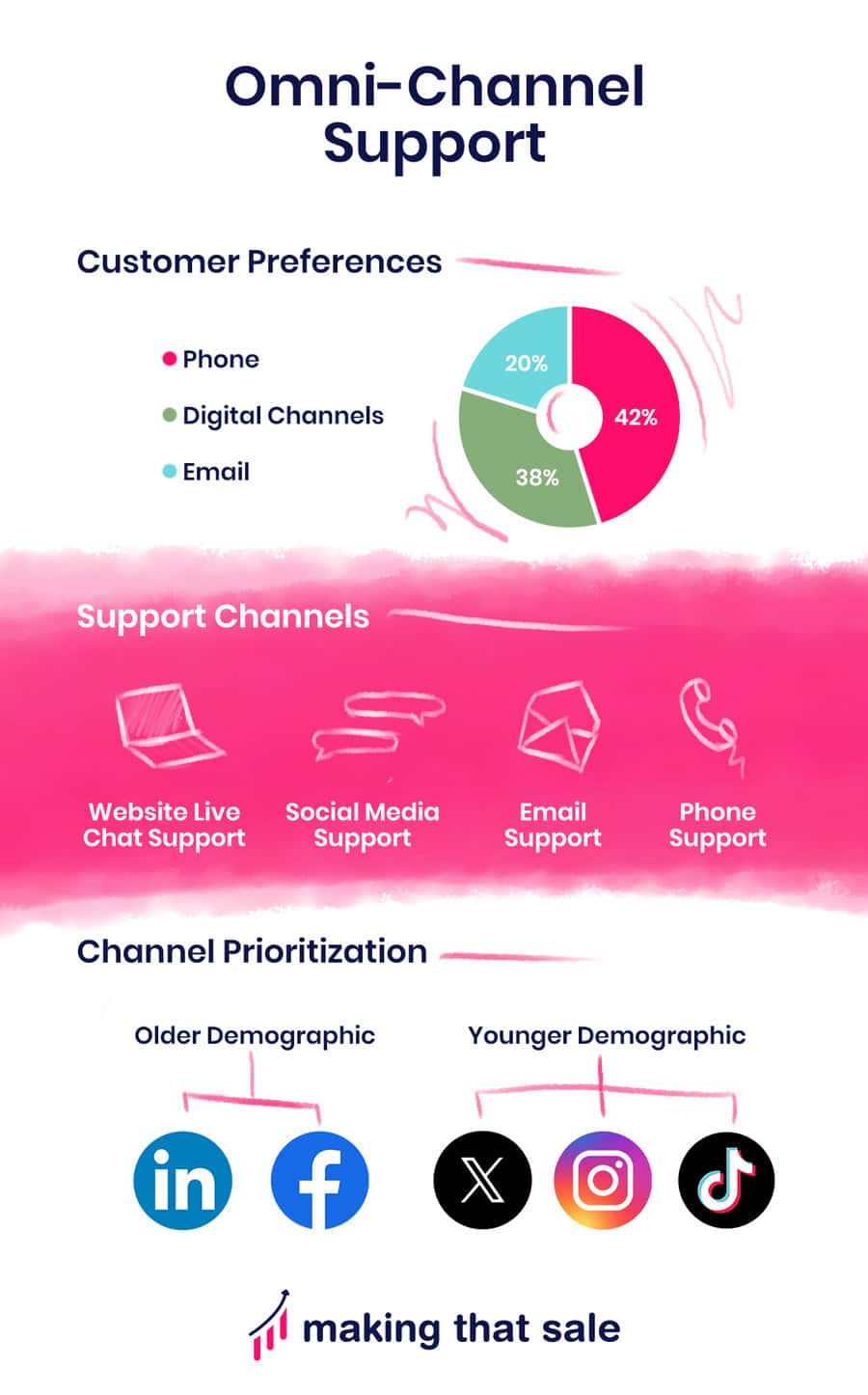In the digital era, one crucial element of a good customer service strategy is a live chat feature on your website and other communication channels. ...
Tips to Improve Customer Satisfaction
Written by: Victoria Yu
Victoria Yu is a Business Writer with expertise in Business Organization, Marketing, and Sales, holding a Bachelor’s Degree in Business Administration from the University of California, Irvine’s Paul Merage School of Business.
Edited by: Sallie Middlebrook
Sallie, holding a Ph.D. from Walden University, is an experienced writing coach and editor with a background in marketing. She has served roles in corporate communications and taught at institutions like the University of Florida.
Updated on November 30, 2023

Tips to Improve Customer Satisfaction
- What is Customer Satisfaction? Why is it Important?
- Seven Tips to Improve Customer Satisfaction
- How Do I Measure Customer Satisfaction?
- Conclusion
As a small business owner, you don’t have the luxury of a never-ending sales funnel or a large market share to guarantee an endless flow of new customers. Instead, in your first few years of business, you’ll have to rely on your few current customers to come back as returning customers and spread the good word about your brand in order to drive growth.
But customers will never return or endorse your business if they’re unhappy with their shopping experience – and with so many other brands selling similar items at the same price point, they’re not short on substitutes if they decide to stop patronizing your business. That’s why customer satisfaction is crucial for small and growing businesses looking to retain and grow their customer base.
So how can you ensure customers are happy and satisfied with their purchase and your brand? Whether you’re the owner or a simple sales rep, this guide will surely have some sound advice to help you improve your business’s customer satisfaction.
Key Takeaways
Customer satisfaction is a measure of how well customers’ expectations of your company have been met and how happy they are with your company as a whole.
Improving customer satisfaction can lead to a unique brand image, higher revenue, and an increased customer base.
Seven tips to improve your customer satisfaction are to enable self-service, provide omni-channel support, improve the customer journey, highlight your USP, train your service reps to have empathy, empower your service reps, and ask for customer feedback.
Whenever you attempt improve customer satisfaction, it’s important to objectively measure whether the change was effective or not using key customer satisfaction performance metrics such as a CSAT score, NPS score, CES score, attribute satisfaction, and repurchase intention.
What is Customer Satisfaction? Why is it Important?
As the name implies, customer satisfaction is a measure of how happy and satisfied customers are with a company’s products, services, customer experience, and brand.
But why should a company care about customer satisfaction? Three main reasons highlight how customer satisfaction can shape your business’s present and future success.
1. Customer Satisfaction Makes Your Business Stand Out
There’s a common misconception that a good product or a low price will sell itself and guarantee a company’s success. However, unless you’ve discovered an industry-breaking new technology or new manufacturing process, at least one other company will likely provide the same product as you at the same price. Market saturation is likely one of the reasons over 20% of businesses fail within their first year and only about half (57%) survive their first five years, according to the most recent data from the Bureau of Labor Statistics.
When faced with dozens of offerings for the same product at the same price, customers increasingly turn to customer experiences to determine if a company is worth doing business with. To that end, guaranteeing customer satisfaction with an efficient sales process and smooth customer service becomes a part of your total product offering. It can mean the difference between your company making a sale and being lost amongst competitors.
2. Satisfied Customers Spend More
Next, customer satisfaction has a marked impact on your company’s bottom line. Every 20% increase in customer satisfaction corresponds to a 15% growth in revenue and a 20% reduction in the cost of serving customers, reports survey software provider Qualtrics.
This makes sense when you think about it: customers happy with their purchases and experiences are likely to become loyal customers and purchase again. With each consecutive purchase, a repeat customer needs less teaching and attention because they’re already familiar with the brand’s products and purchasing process. Because they trust your brand, repeat customers with the best past experiences spend 140% more than customers with poor past experiences, according to a study by the Harvard Business Review.
3. A Satisfied Customer Brings In More Customers
Finally, customer satisfaction can shape the future success of your company. If they’re absolutely blown away by their experience, a single happy customer can become a brand ambassador for your company, referring you to their friends, family, and other coworkers. Consumers will naturally follow in the footsteps of other consumer endorsements, a concept known as social proof. This means that one well-placed recommendation or referral from a brand ambassador could net more customers than a hundred paid advertisements.
Rather than investing heavily into a marketing campaign, a small business could instead cover two functions—marketing and sales— with one and drive awareness and growth through great customer satisfaction. As your reputation for good service improves, more and more new customers will be drawn in.
Seven Tips to Improve Customer Satisfaction
With those enticing benefits in mind, you might be eager to begin improving your customer satisfaction level right away. But how do you do that?
Some companies conflate good customer service with “smothering the customer at all stages of the sales process.” But if you’ve ever been personally subjected to a pushy sales rep before, you’ll understand first-hand that an overbearing salesperson is the fastest way to kill any customer satisfaction.
Unfortuately, satisfaction levels aren’t something you can improve simply through bootstrapping and elbow grease – a certain degree of finesse and understanding of human psychology is required. Improving customer satisfaction without being overbearing is a delicate balance for companies to manage. Rather than overwhelming the customer on all fronts, here are seven concrete, actionable tips to help you improve your customer satisfaction.
1. Empower Customers With Self-Service
To start off, take a moment to ask yourself: do customers really need your sales rep’s tender one-on-one care for every little thing? For most simple questions and purchases, probably not.
Instead, empower customers to educate themselves with an FAQ section on your website and help themselves through tools like self-checkout. This gives the customer a feeling of capability and allows customers to take the sale at their own pace without feeling any pressure from a sales rep. Overall, the customer has a much more relaxed experience when they can serve themselves, leading to a higher level of satisfaction with no active input from your company.
The power of self-service can be seen close at home with the rise of self-checkout stations in convenience grocery stores. In fact, over two-thirds of grocery retailers in the US and UK believe that their customers would switch merchants if they didn’t offer self-service kiosks! This goes to show that for simpler and routine purchases, customers are much happier to serve themselves than to bother with an employee.
Of course, your sales reps and support staff should always be close at hand in case your customer needs help. And if you sell more complex, customized, or expensive products, your sales rep will of course have to step in to iron out all the details and offer personalized recommendations. But if you’re selling more elementary products and services, there’s really no need for your reps to be personally involved in every purchase.
As an added bonus with self-service, your reps will have more time to relax and be more available to handle higher-ticket issues, leading to higher employee satisfaction as well as customer satisfaction. That’s two types of satisfaction in one fell swoop!
2. Provide Omni-Channel Support
When self-service fails and your customers need help, how will they try to contact you? Be sure to invest ample resources into monitoring these communication channels and quickly responding to any customer query that comes in.
Some common channels customers use are:
- Website live chat support
- Social media support
- Email support
- Phone support
A study by Statista in 2020 revealed that the channels customers preferred the most to resolve customer service issues were phone (42%), digital channels (38%), and email (20%). Thus, your customer service reps should accordingly prioritize your phones, social media accounts, and email inboxes in order to meet customers where they are and provide immediate support.
Providing speedy and faithful customer service across all channels gives you more happy customers, boosting your brand’s reputation from all angles.
If you have social media accounts on multiple platforms, you should prioritize monitoring the accounts most suited to your client base. For example, if you’re a B2B company with an older target demographic, you might prioritize LinkedIn and Facebook, while a B2C company with a younger target demographic might prefer Twitter, Instagram, and TikTok.
If you find that you have more communications channels than your customer service department can handle, you can use canned and automated messages to redirect and consolidate customers to your more well-staffed channels. For example, if you have a little-used Snapchat account, you could set up an automated message thanking a messaging customer for their query, letting them know that responses may be a little slow over Snapchat, and inviting them to call your service line for urgent matters.

3. Improve The Customer Journey
Rather than focusing only on customer-rep interactions, customer satisfaction can be improved by focusing on improving the customer journey as a whole, creating a smooth and pleasant customer experience.
Though people might conflate customer service with customer satisfaction, the former is usually a byproduct of the latter: customers only call the customer service department when they’re dissatisfied with the information, product, or process and need a direct intervention to fix their situation. Customers are more satisfied if they don’t have to call the customer service department in the first place. McKinsey backs this up by showing that a company’s performance on customer journeys is 35% more predictive of customer satisfaction than performance on individual touchpoints.
In other words, if your customer journey is self-sufficient in providing an excellent customer experience, then customers will feel satisfied even without direct customer service.
To that end, you can improve your customer journey by putting yourself in the customer’s shoes and mapping out all of the touchpoints and actions a customer takes before, during, and after their purchase. For each communication and purchasing channel, ensure that the customer can locate the information and steps they need to take to complete each stage of the sales process.
4. Highlight Your Company’s Promise
As you built your company, you should have developed a unique selling proposition (USP), a key statement of what makes your business different from its competitors. This USP becomes the basis of your promise to customers when they shop at your business.
Rather than silently fulfilling the USP, your company can raise customer trust and satisfaction by actively promoting your USP, raising customer expectations and building trust when the promise is fulfilled.
When you state your USP in your marketing materials and promotions, this creates an expectation in customers’ minds on the quality of your company and product. As you consistently meet this customer expectation, customers will begin to trust you more, boosting their emotional satisfaction.
Even if every other element of your product is subpar, customers will at least feel the slightest sliver of satisfaction that you were honest about your USP, which is likely the product element that matters the most to them and drew them to your company in the first place.
Some examples of USPs are:
- “Melts in your mouth, not your hand” —M&M’s
- “Made to be worn” —Ralph Lauren
- “Love your beverage or let us know. We’ll always make it right” —Starbucks
5. Train Your Customer Service Reps
No matter how hard you improve your customer journey, there will always be a few customers who still need a little more help from your customer service department. When interacting with these customers, your customer service reps can create an outstanding customer experience through empathy and active listening skills.
During the course of the conversation, service agents should have empathy for each client’s issue by understanding the problem, being sensitive to the client’s emotions, and empathizing with them. While the ultimate goal is to solve customers’ problems, an expression of empathy, even as simple as “I understand how that’s an issue,” validates the customer’s emotions and builds a bond between the customer and rep.
A tool service reps can use to help develop and display empathy is active listening, which is a suite of skills that helps a rep show customers that they’re listening through body language and repeating the customer’s comments, and exploring the deeper emotions behind each statement.
Some nonverbal active listening skills are maintaining eye contact, leaning towards a person, sitting still, and not interrupting while the customer talks. Then, when the customer is done, the rep should practice verbal active listening skills such as restating what the customer said, reflecting on what they’re feeling, or asking open-ended questions.
If you’re interested in learning more, the US Institute of Peace provides lesson plans and materials for leaders to teach active listening skills to teams in under an hour.
Only when the customer service rep truly understands and empathizes with the customer can they become passionate about solving the customer’s problem, ensuring that everything in their power is done to solve the issue and ensure the customer walks away happy.
6. Give Service Reps Authority
Even if a customer service agent strongly empathizes with a customer’s plight, a customer will remain dissatisfied unless the agent can take the proper corrective actions to resolve the issue. To that end, customer service agents should be given the information, tools, and authority to solve most customer service issues without consulting another department.
In a study of important aspects of a good customer experience by Statista, approximately 21% of customers consider not having to repeat themselves to another representative as important, and approximately 33% of customers believe it’s important to solve their issue in a single interaction, regardless of how long it takes. This means that companies should keep redirections down to a minimum to keep customers happy.
The most basic tool agents should have is the ability to look into customer profiles and accounts to give them a more holistic sense of a customer’s situation, helping them diagnose the problem faster. Another key tool should be the authority to offer discounts and refunds without the input of anyone from the department.
Of course, you’ll have to be certain that your reps can make those judgment calls and handle that responsibility. But customers will be much more satisfied with their experience if issues are solved swiftly and empathetically by the first customer service rep they meet.
7. Ask For Customer Feedback
Our final tip for improving customer satisfaction is to never stop improving customer satisfaction by making it a habit of asking for feedback from the customers themselves.
Even if you implement all of the tips we mentioned above, the only true way to determine if it improved customer satisfaction is by asking the customers directly if they’re satisfied or not. To that end, a company should send and collect customer satisfaction surveys to conclude if certain processes are beneficial or not. Surveys should be sent out immediately after each step in the sales process, using the channel the customer communicates with the company through (email, phone, or social media).
A company that receives negative feedback should take steps to fix it immediately – Deloitte reports that traditional customer feedback is often reviewed days or weeks after the actual event, which is days and weeks that a customer stews in their negative emotions and espouses the company to all their friends.
And who knows? Maybe a customer has a suggestion to improve your customer journey that your employees never even considered, providing actionable steps to improve customer satisfaction without investing time and money into investigating the customer journey yourself.
Even if a customer doesn’t have any comments or recommendations to make, simply asking for feedback makes the individual customer feel like their voice is being heard by the company.
By collecting customer feedback and immediately acting upon it, a company can continuously improve its customer journey and make customers feel valued.
How Do I Measure Customer Satisfaction?
Though we’ve listed seven general tips to improve customer satisfaction, it’s unlikely that all of them will apply to your business and be effective. So how can you distinguish between effective and ineffective tips and quantitatively measure customer satisfaction?
There are five common metrics used to measure customer satisfaction:
- A customer satisfaction score (CSAT Score) that broadly asks for a customer’s overall satisfaction,
- A Net Promoter Score (NPS Score) that measures how likely a customer is to recommend the company or product to a friend,
- A Customer Effort Score (CES Score) that measures how easy or difficult the customer’s experience was,
- Attribute satisfaction that measures a customer’s satisfaction with specific product or service elements,
- Repurchase intention that measures if the customer is satisfied enough to consider shopping from your brand again.
Rather than only asking for a broad CSAT score, companies would be wise to measure several aspects of customer satisfaction to get a more complete picture of their customers. Once you’ve identified an aspect of your customer journey you’d like to improve, use surveys to measure the appropriate customer satisfaction metrics both before and after to conclusively determine if our recommended tips work for you.
Conclusion
As a company scales up, it must ensure that beyond providing excellent customer service to individual customers, its entire customer base is satisfied with their experiences. To that end, these seven tips help you ensure that your customers are satisfied from the get-go by creating an amazing customer journey with or without the involvement of customer service agents. By implementing these tips, any consumer shopping at your business will be sure to have a positive experience and come back as a loyal customer.
FAQs
The two are cause and effect: good customer service causes customer satisfaction. However, a customer doesn’t have to experience good customer service to be satisfied.
Customer service implies action on the company’s part to interact with the customer in a positive way – an employee must actively provide a service to the customer. On the other hand, a customer can be satisfied even without interacting with the company’s employees as long as their expectations for their transaction are met.
For example, consider self-checkout and self-service stations. Even if there’s no direct service on the business’s part, the customer is still satisfied because they can complete their transaction quickly and easily with no fuss.
Global management consulting titan McKinsey & Company identified three key components of customer satisfaction: customer journey consistency, emotional consistency, and communication consistency. In other words, a company can improve customer satisfaction by having a repeatable customer experience shared across all customers and channels, inspiring trust in their customers, and building a brand image by repeatedly restating the company’s promises to customers.
Unfortunately, as customer satisfaction is a byproduct of your entire customer journey and business operations, there’s no one software solution that can promise to boost customer satisfaction as a whole.
However, there are certain tools that can help you execute some of the tips we outlined above:
- Customer support software such as Zendesk, Zapier, and Zoho Desk can centralize all email, phone, chat, and social media messages into one platform for easy management, providing automated responses, and storing customer information for future reference.
- A CRM such as HubSpot CRM, Salesforce CRM, Zoho CRM, and Sage CRM can track your customer journey and touchpoints and help your sales reps build more personalized customer relationships.
- Survey software such as Qualtrics, SurveyMonkey, and Qualaroo can help you collect customer feedback through different channels.
Featured Resources

50 Key Live Chat Statistics You Should Know
Published on April 10, 2024
Read Now

50 Customer Service Statistics and Facts to Know
Published on March 18, 2024
If, as a business owner, you believe “The customer is always right,” then customer service is and always will be a cornerstone of yourbusiness&# ...
Read Now

How to Conduct a Customer Needs Assessment
Published on February 20, 2024
Knowing what your customers want and need to purchase should be your first priority as a business owner or manager. Every business needs ongoingreve ...
Read Now
